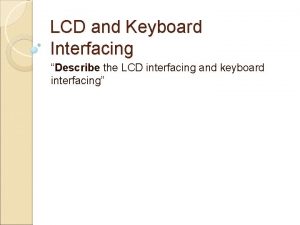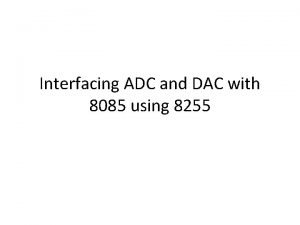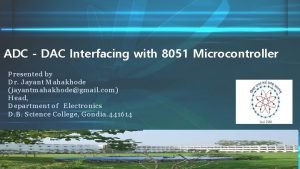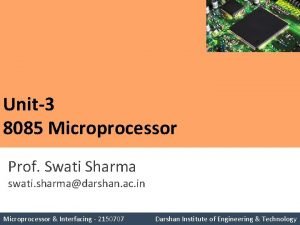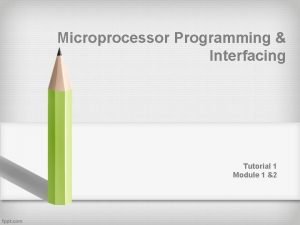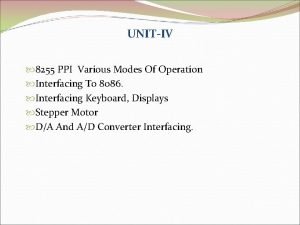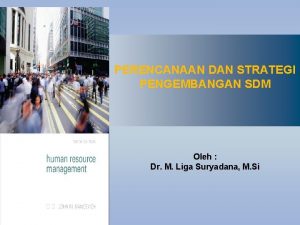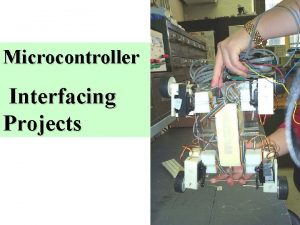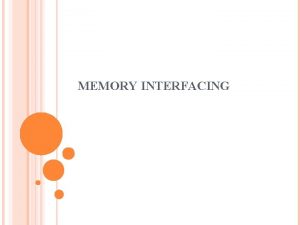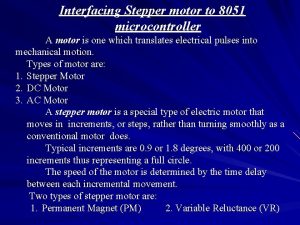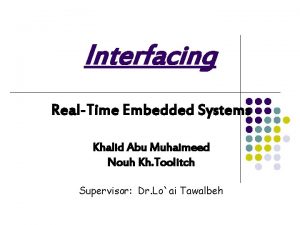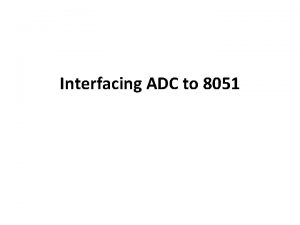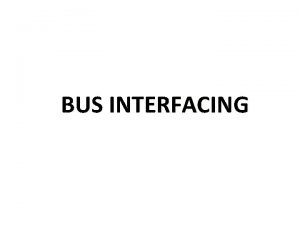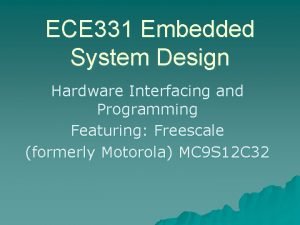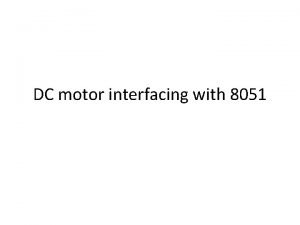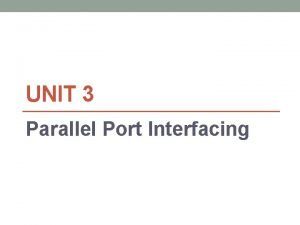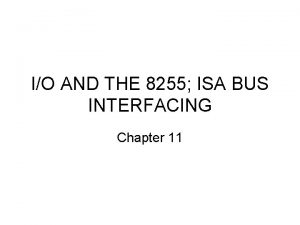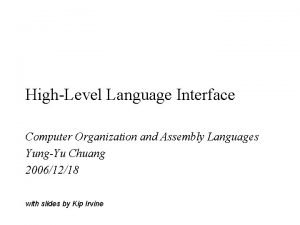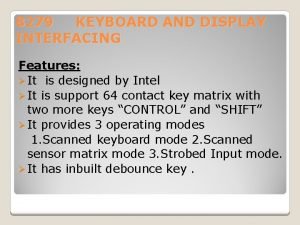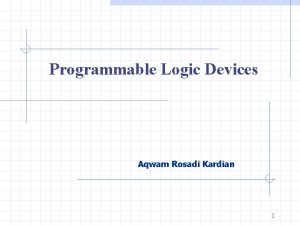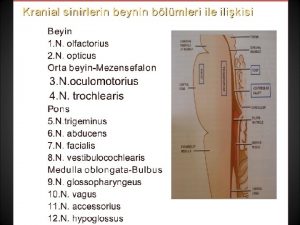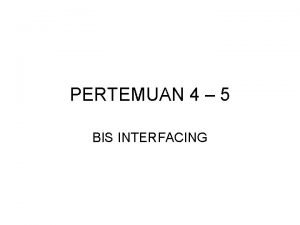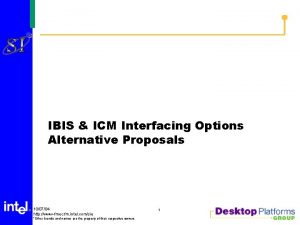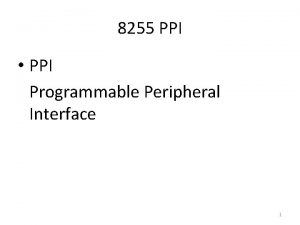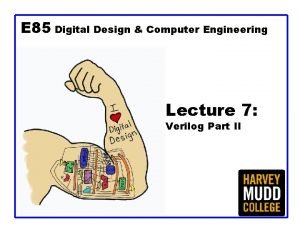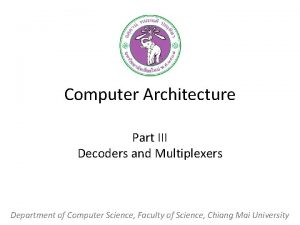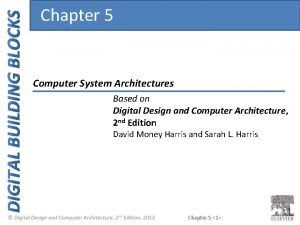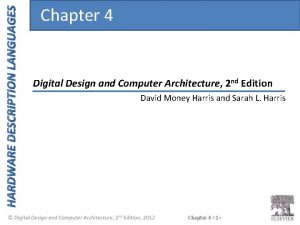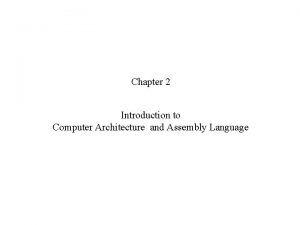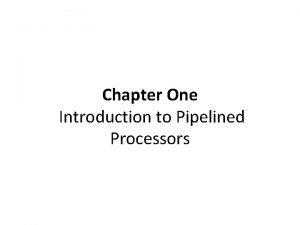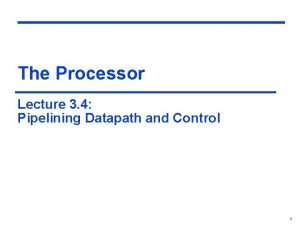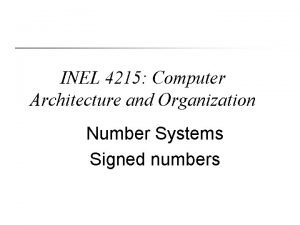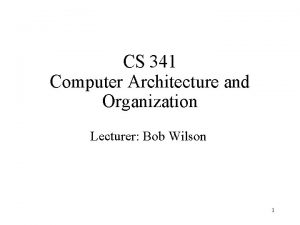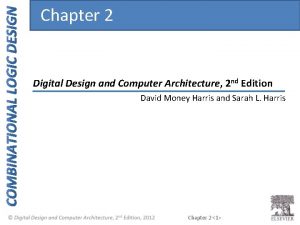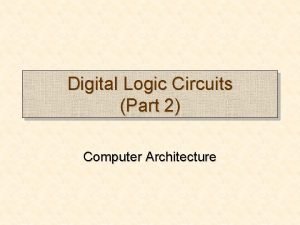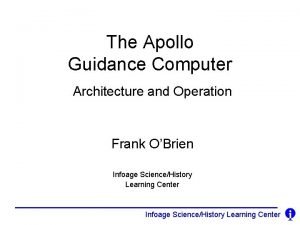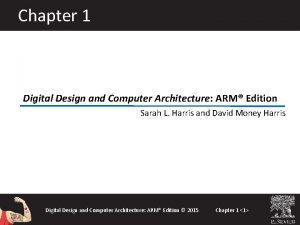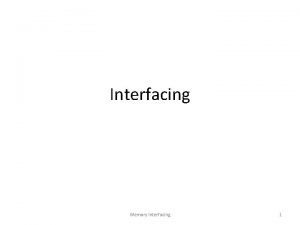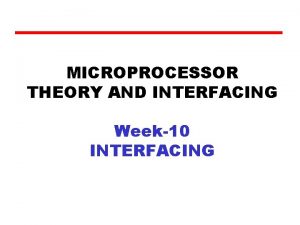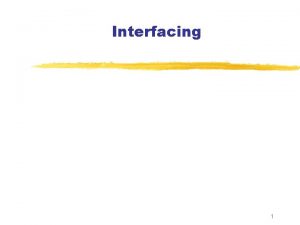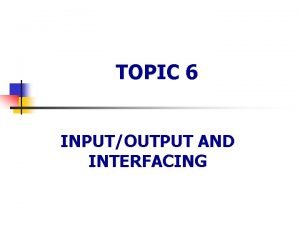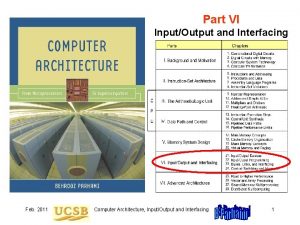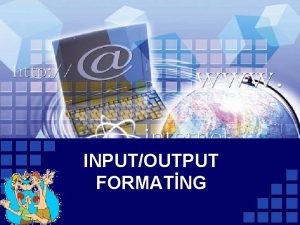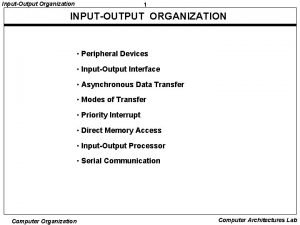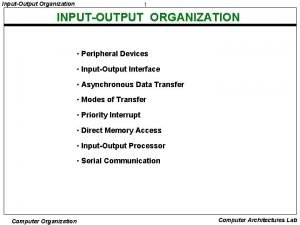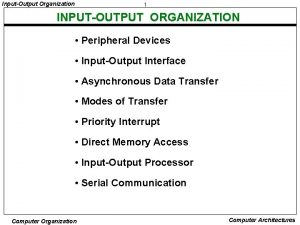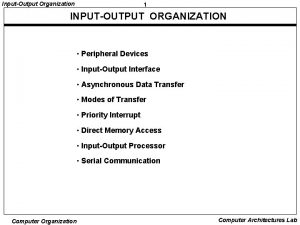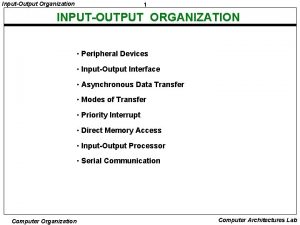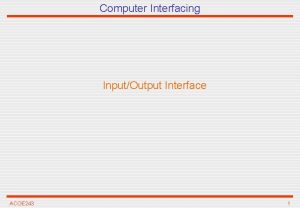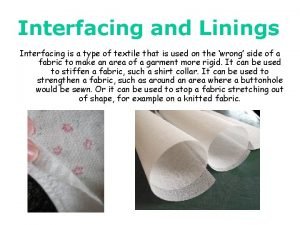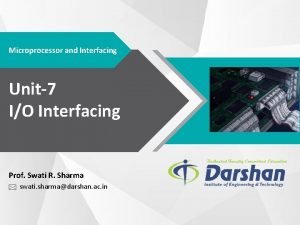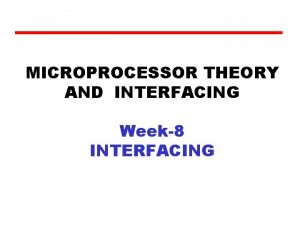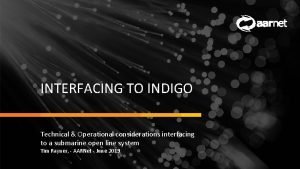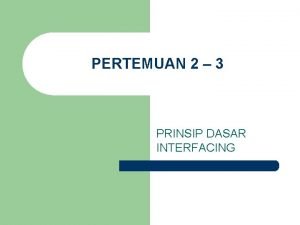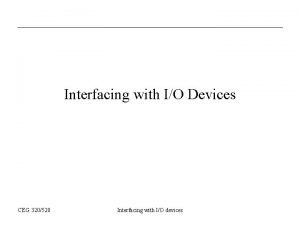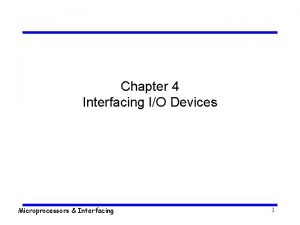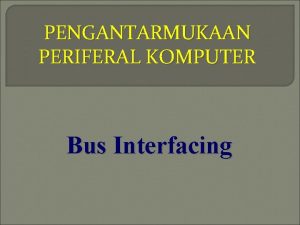Part VI InputOutput and Interfacing Computer Architecture InputOutput



































































- Slides: 67

Part VI Input/Output and Interfacing Computer Architecture, Input/Output and Interfacing 1

VI Input/Output and Interfacing Effective computer design & use requires awareness of: • I/O device types, technologies, and performance • Interaction of I/O with memory and CPU • Automatic data collection and device actuation Topics in This Part Chapter 21 Input/Output Devices Chapter 22 Input/Output Programming Chapter 23 Buses, Links, and Interfacing Chapter 24 Context Switching and Interrupts Computer Architecture, Input/Output and Interfacing 2

21 Input/Output Devices Learn about input and output devices as categorized by: • Type of data presentation or recording • Data rate, which influences interaction with system Topics in This Chapter 21. 1 Input/Output Devices and Controllers 21. 2 Keyboard and Mouse 21. 3 Visual Display Units 21. 4 Hard-Copy Input/Output Devices 21. 5 Other Input/Output Devices 21. 6 Networking of Input/Output Devices Computer Architecture, Input/Output and Interfacing 3

Section 21. 1: Introduction Section 21. 3 Section 21. 4 Section 21. 2 Section 21. 5: Other devices Section 21. 6: Networked I/O Computer Architecture, Input/Output and Interfacing 4

21. 1 Input/Output Devices and Controllers Table 3. 3 Some input, output, and two-way I/O devices. Input type Prime examples Other examples Data rate (b/s) Main uses Symbol Keyboard, keypad Music note, OCR 10 s Ubiquitous Position Mouse, touchpad Stick, wheel, glove 100 s Ubiquitous Identity Barcode reader Badge, fingerprint 100 s Sales, security Sensory Touch, motion, light Scent, brain signal 100 s Control, security Audio Microphone Phone, radio, tape 1000 s Ubiquitous Image Scanner, camera Graphic tablet 1000 s-106 s Photos, publishing Video Camcorder, DVD VCR, TV cable 1000 s-109 s Entertainment Output type Prime examples Other examples Data rate (b/s) Main uses Symbol LCD line segments LED, status light 10 s Ubiquitous Position Stepper motor Robotic motion 100 s Ubiquitous Warning Buzzer, bell, siren Flashing light A few Safety, security Sensory Braille text Scent, brain stimulus 100 s Personal assistance Audio Speaker, audiotape Voice synthesizer 1000 s Ubiquitous Image Monitor, printer Plotter, microfilm 1000 s Ubiquitous Video Monitor, TV screen Film/video recorder 1000 s-109 s Entertainment Two-way I/O Prime examples Other examples Data rate (b/s) Main uses Mass storage Hard/floppy disk CD, tape, archive 106 s Ubiquitous Network Modem, fax, LAN Cable, DSL, ATM 1000 s-109 s Ubiquitous Computer Architecture, Input/Output and Interfacing 5

Simple Organization for Input/Output Figure 21. 1 Input/output via a single common bus. Computer Architecture, Input/Output and Interfacing 6

I/O Organization for Greater Performance Proprietary Standard Figure 21. 2 Input/output via intermediate and dedicated I/O buses (to be explained in Chapter 23). Computer Architecture, Input/Output and Interfacing 7

21. 2 Keyboard and Mouse Computer Architecture, Input/Output and Interfacing 8

Keyboard Switches and Encoding Figure 21. 3 Two mechanical switch designs and the logical layout of a hex keypad. Computer Architecture, Input/Output and Interfacing 9

Pointing Devices Computer Architecture, Input/Output and Interfacing 10

How a Mouse Works Figure 21. 4 Mechanical and simple optical mice. Computer Architecture, Input/Output and Interfacing 11

21. 3 Figure 21. 5 Visual Display Units CRT display unit and image storage in frame buffer. Computer Architecture, Input/Output and Interfacing 12

How Color CRT Displays Work Figure 21. 6 The RGB color scheme of modern CRT displays. Computer Architecture, Input/Output and Interfacing 13

Encoding Colors in RGB Format Besides hue, saturation is used to affect the color’s appearance (high saturation at the top, low saturation at the bottom) Computer Architecture, Input/Output and Interfacing 14

Flat-Panel Displays Figure 21. 7 Passive and active LCD displays. Computer Architecture, Input/Output and Interfacing 15

Other Display Technologies Computer Architecture, Input/Output and Interfacing 16

21. 4 Hard-Copy Input/Output Devices Figure 21. 8 Scanning mechanism for hard-copy input. Computer Architecture, Input/Output and Interfacing 17

Character Formation by Dot Matrices Same dot matrix size, but with greater resolution Figure 21. 9 Forming the letter “D” via dot matrices of varying sizes. Computer Architecture, Input/Output and Interfacing 18

Simulating Intensity Levels via Dithering Forming five gray levels on a device that supports only black and white (e. g. , ink-jet or laser printer) Using the dithering patterns above on each of three colors forms 5 5 5 = 125 different colors Computer Architecture, Input/Output and Interfacing 19

Simple Dot-Matrix Printer Mechanism Computer Architecture, Input/Output and Interfacing 20

Common Hard-Copy Output Devices Figure 21. 10 Ink-jet and laser printers. Computer Architecture, Input/Output and Interfacing 21

How Color Printers Work Red Green The RGB scheme of color monitors is additive: various amounts of the three primary colors are added to form a desired color Blue Cyan Magenta Absence of green The CMY scheme of color printers is subtractive: various amounts of the three primary colors are removed from white to form a desired color Yellow To produce a more satisfactory shade of black, the CMYK scheme is often used (K = black) Computer Architecture, Input/Output and Interfacing 22

The CMYK Printing Process Illusion of full color created with CMYK dots Computer Architecture, Input/Output and Interfacing 23

Color Wheels Artist’s color wheel, used for mixing paint Subtractive color wheel, used in printing (CMYK) Additive color wheel, used for projection Primary colors appear at center and equally spaced around the perimeter Secondary colors are midway between primary colors Tertiary colors are between primary and secondary colors Source of this and several other slides on color: http: //www. devx. com/projectcool/Article/19954/0/ (see also color theory tutorial: http: //graphics. kodak. com/documents/Introducing%20 Color%20 Theory. pdf) Computer Architecture, Input/Output and Interfacing 24

21. 5 Other Input/Output Devices Computer Architecture, Input/Output and Interfacing 25

Sensors and Actuators Collecting info about the environment and other conditions Light sensors (photocells) Temperature sensors (contact and noncontact types) Pressure sensors Figure 21. 11 Stepper motor principles of operation. Computer Architecture, Input/Output and Interfacing 26

21. 6 Networking of Input/Output Devices Figure 21. 12 With network-enabled peripherals, I/O is done via file transfers. Computer Architecture, Input/Output and Interfacing 27

Input/Output in Control and Embedded Systems Figure 21. 13 The structure of a closed-loop computer-based control system. Computer Architecture, Input/Output and Interfacing 28

22 Input/Output Programming Like everything else, I/O is controlled by machine instructions • I/O addressing (memory-mapped) and performance • Scheduled vs demand-based I/O: polling vs interrupts Topics in This Chapter 22. 1 I/O Performance and Benchmarks 22. 2 Input/Output Addressing 22. 3 Scheduled I/O: Polling 22. 4 Demand-Based I/O: Interrupts 22. 5 I/O Data Transfer and DMA 22. 6 Improving I/O Performance Computer Architecture, Input/Output and Interfacing 29

22. 1 I/O Performance and Benchmarks Example 22. 1: The I/O wall An industrial control application spent 90% of its time on CPU operations when it was originally developed in the early 1980 s. Since then, the CPU component has been upgraded every 5 years, but the I/O components have remained the same. Assuming that CPU performance improved tenfold with each upgrade, derive the fraction of time spent on I/O over the life of the system. Solution Apply Amdahl’s law with 90% of the task speeded up by factors of 10, 1000, and 10000 over a 20 -year period. In the course of these upgrades the running time has been reduced from the original 1 to 0. 1 + 0. 9/10 = 0. 19, 0. 1009, and 0. 10009, making the fraction of time spent on input/output 52. 6, 91. 7, 99. 1, and 99. 9%, respectively. The last couple of CPU upgrades did not really help. Computer Architecture, Input/Output and Interfacing 30

Types of Input/Output Benchmark Supercomputer I/O benchmarks Reading large volumes of input data Writing many snapshots for checkpointing Saving a relatively small set of results I/O data throughput, in MB/s, is important Transaction processing I/O benchmarks Huge database, but each transaction fairly small A handful (2 -10) of disk accesses per transaction I/O rate (disk accesses per second) is important File system I/O benchmarks File creation, directory management, indexing, . . . Benchmarks are usually domain-specific Computer Architecture, Input/Output and Interfacing 31

22. 2 Input/Output Addressing Figure 22. 1 Control and data registers for keyboard and display unit in Mini. MIPS. Computer Architecture, Input/Output and Interfacing 32

Hardware for I/O Addressing Figure 22. 2 Addressing logic for an I/O device controller. Computer Architecture, Input/Output and Interfacing 33

Data Input from Keyboard Example 22. 2 Write a sequence of Mini. MIPS assembly language instructions to make the program wait until the keyboard has a symbol to transmit and then read the symbol into register $v 0. Solution The program must continually examine the keyboard control register, ending its “busy wait” when the R bit has been asserted. lui idle: lw andi beq lw $t 0, 0 xffff $t 1, 0($t 0) $t 1, 0 x 0001 $t 1, $zero, idle $v 0, 4($t 0) # # # put 0 xffff 0000 in $t 0 get keyboard’s control word isolate the LSB (R bit) if not ready (R = 0), wait retrieve data from keyboard This type of input is appropriate only if the computer is waiting for a critical input and cannot continue in the absence of such input. Computer Architecture, Input/Output and Interfacing 34

Data Output to Display Unit Example 22. 3 Write a sequence of Mini. MIPS assembly language instructions to make the program wait until the display unit is ready to accept a new symbol and then write the symbol from $a 0 to the display unit. Solution The program must continually examine the display unit’s control register, ending its “busy wait” when the R bit has been asserted. lui idle: lw andi beq sw $t 0, 0 xffff $t 1, 8($t 0) $t 1, 0 x 0001 $t 1, $zero, idle $a 0, 12($t 0) # # # put 0 xffff 0000 in $t 0 get display’s control word isolate the LSB (R bit) if not ready (R = 0), wait supply data to display unit This type of output is appropriate only if we can afford to have the CPU dedicated to data transmission to the display unit. Computer Architecture, Input/Output and Interfacing 35

22. 3 Scheduled I/O: Polling Examples 22. 4, 22. 5, 22. 6 What fraction of a 1 GHz CPU’s time is spent polling the following devices if each polling action takes 800 clock cycles? Keyboard must be interrogated at least 10 times per second Floppy sends data 4 bytes at a time at a rate of 50 KB/s Hard drive sends data 4 bytes at a time at a rate of 3 MB/s Solution For keyboard, divide the number of cycles needed for 10 interrogations by the total number of cycles available in 1 second: (10 800)/109 0. 001% The floppy disk must be interrogated 50 K/4 = 12. 5 K times per sec (12. 5 K 800)/109 1% The hard disk must be interrogated 3 M/4 = 750 K times per sec (750 K 800)/109 60% Computer Architecture, Input/Output and Interfacing 36

22. 4 Demand-Based I/O: Interrupts Example 22. 7 Consider the disk in Example 22. 6 (transferring 4 B chunks of data at 3 MB/s when active). Assume that the disk is active 5% of the time. The overhead of interrupting the CPU and performing the transfer is 1200 clock cycles. What fraction of a 1 GHz CPU’s time is spent attending to the hard disk drive? Solution When active, the hard disk produces 750 K interrupts per second 0. 05 (750 K 1200)/109 4. 5% (compare with 60% for polling) Note that even though the overhead of interrupting the CPU is higher than that of polling, because the disk is usually idle, demand-based I/O leads to better performance. Computer Architecture, Input/Output and Interfacing 37

Interrupt Handling Upon detecting an interrupt signal, provided the particular interrupt or interrupt class is not masked, the CPU acknowledges the interrupt (so that the device can deassert its request signal) and begins executing an interrupt service routine. 1. Save the CPU state and call the interrupt service routine. 2. Disable all interrupts. 3. Save minimal information about the interrupt on the stack. 4. Enable interrupts (or at least higher priority ones). 5. Identify cause of interrupt and attend to the underlying request. 6. Restore CPU state to what existed before the last interrupt. 7. Return from interrupt service routine. The capability to handle nested interrupts is important in dealing with multiple high-speed I/O devices. Computer Architecture, Input/Output and Interfacing 38

22. 5 I/O Data Transfer and DMA Figure 22. 3 DMA controller shares the system or memory bus with the CPU. Computer Architecture, Input/Output and Interfacing 39

DMA Operation Figure 22. 4 DMA operation and the associated transfers of bus control. Computer Architecture, Input/Output and Interfacing 40

22. 6 Improving I/O Performance Example 22. 9: Effective I/O bandwidth from disk Consider a hard disk drive with 512 B sectors, average access latency of 10 ms, and peak throughput of 10 MB/s. Plot the variation of the effective I/O bandwidth as the unit of data transfer (block) varies in size from 1 sector (0. 5 KB) to 1024 sectors (500 KB). Solution 5 MB/s 0. 05 MB/s Figure 22. 5 Computer Architecture, Input/Output and Interfacing 41

Distributed Input/Output Figure 22. 6 Example configuration for the Infiniband distributed I/O. Computer Architecture, Input/Output and Interfacing 42

23 Buses, Links, and Interfacing Shared links or buses are common in modern computers: • Fewer wires and pins, greater flexibility & expandability • Require dealing with arbitration and synchronization Topics in This Chapter 23. 1 Intra- and Intersystem Links 23. 2 Buses and Their Appeal 23. 3 Bus Communication Protocols 23. 4 Bus Arbitration and Performance 23. 5 Basics of Interfacing 23. 6 Interfacing Standards Computer Architecture, Input/Output and Interfacing 43

23. 1 Intra- and Intersystem Links Figure 23. 1 Multiple metal layers provide intrasystem connectivity on microchips or printed-circuit boards. Computer Architecture, Input/Output and Interfacing 44

Multiple Metal Layers on a Chip or PC Board Cross section of metal layers Active elements and their connectors Modern chips have 8 -9 metal layers Upper layers carry longer wires as well as those that need more power Computer Architecture, Input/Output and Interfacing 45

Intersystem Links Figure 23. 2 Example intersystem connectivity schemes. Figure 23. 3 RS-232 serial interface 9 -pin connector. Computer Architecture, Input/Output and Interfacing 46

Intersystem Communication Media Figure 23. 4 Commonly used communication media for intersystem connections. Computer Architecture, Input/Output and Interfacing 47

Comparing Intersystem Links Table 23. 1 Summary of three interconnection schemes. Interconnection properties RS-232 Ethernet ATM Maximum segment length (m) 10 s 1000 s Maximum network span (m) 10 s 100 s Unlimited Up to 0. 02 10/1000 155 -2500 1 100 s 53 <1 10 s-100 s Input/Output LAN Backbone Low High Bit rate (Mb/s) Unit of transmission (B) Typical end-to-end latency (ms) Typical application domain Transceiver complexity or cost Computer Architecture, Input/Output and Interfacing 48

23. 2 Buses and Their Appeal 1 0 1 2 0 3 n– 1 n– 2 2 3 n– 1 n– 2 Point-to-point connections between n units require n(n – 1) channels, or n(n – 1)/2 bidirectional links; that is, O(n 2) links Bus connectivity requires only one input and one output port per unit, or O(n) links in all Computer Architecture, Input/Output and Interfacing 49

Bus Components and Types Figure 23. 5 The three sets of lines found in a bus. A typical computer may use a dozen or so different buses: 1. Legacy Buses: PC bus, ISA, RS-232, parallel port 2. Standard buses: PCI, SCSI, USB, Ethernet 3. Proprietary buses: for specific devices and max performance Computer Architecture, Input/Output and Interfacing 50

23. 3 Bus Communication Protocols Figure 23. 6 Synchronous bus with fixed-latency devices. Figure 23. 7 Handshaking on an asynchronous bus for an input operation (e. g. , reading from memory). Computer Architecture, Input/Output and Interfacing 51

Example Bus Operation Figure 23. 8 I/O read operation via PCI bus. Computer Architecture, Input/Output and Interfacing 52

23. 4 Bus Arbitration and Performance Figure 23. 9 General structure of a centralized bus arbiter. Computer Architecture, Input/Output and Interfacing 53

Daisy Chaining Figure 23. 9 Daisy chaining allows a small centralized arbiter to service a large number of devices that use a shared resource. Computer Architecture, Input/Output and Interfacing 54

23. 5 Basics of Interfacing Figure 23. 11 Wind vane supplying an output voltage in the range 0 -5 V depending on wind direction. Computer Architecture, Input/Output and Interfacing 55

23. 6 Table 23. 2 Attributes Interfacing Standards Summary of four standard interface buses. Name Type of bus PCI SCSI Fire. Wire Backplan Parallel I/O Serial I/O e Serial I/O IEEE 1394 USB 2. 0 Fast I/O Low-cost I/O 32 -64 8 -32 2 1 Peak bandwidth (MB/s) 133 -512 5 -40 12. 5 -50 0. 2 -15 Maximum number of devices 1024* 7 -31# 63 127$ Standard designation PCI Typical application domain System Bus width (data bits) Notes: * span 32 per bus Maximum (m)segment; ANSI X 3. 131 USB #< One width; 1 less than bus 3 -25 $ $ With hubs (repeaters) 4. 5 -72 5 -30$ Centraliz Distribute and Interfacing Arbitration method. Computer Architecture, Input/Output Self-select ed d Daisy 56 chain

Standard Connectors Figure 23. 12 USB connectors and connectivity structure. Figure 23. 13 IEEE 1394 (Fire. Wire) connector. The same connector is used at both ends. Computer Architecture, Input/Output and Interfacing 57

24 Context Switching and Interrupts OS initiates I/O transfers and awaits notification via interrupts • When an interrupt is detected, the CPU switches context • Context switch can also be used between users/threads Topics in This Chapter 24. 1 System Calls for I/O 24. 2 Interrupts, Exceptions, and Traps 24. 3 Simple Interrupt Handling 24. 4 Nested Interrupts 24. 5 Types of Context Switching 24. 6 Threads and Multithreading Computer Architecture, Input/Output and Interfacing 58

24. 1 System Calls for I/O Why the user must be isolated from details of I/O operations Protection: User must be barred from accessing some disk areas Convenience: No need to learn details of each device’s operation Efficiency: Most users incapable of finding the best I/O scheme I/O abstraction: grouping of I/O devices into a small number of generic types so as to make the I/O device-independent Character stream I/O: get(●), put(●) – e. g. , keyboard, printer Block I/O: seek(●), read(●), write(●) – e. g. , disk Network Sockets: create socket, connect, send/receive packet Clocks or timers: set up timer (get notified via an interrupt) Computer Architecture, Input/Output and Interfacing 59

24. 2 Interrupts, Exceptions, and Traps Interrupt Exception Trap Figure 24. 1 Both general term for any diversion and the I/O type Caused by an illegal operation (often unpredictable) AKA “software interrupt” (preplanned and not rare) The notions of interrupts and nested interrupts. Computer Architecture, Input/Output and Interfacing 60

24. 3 Simple Interrupt Handling Acknowledge the interrupt by asserting the Int. Ack signal Notify the CPU’s next-address logic that an interrupt is pending Set the interrupt mask so that no new interrupt is accepted Figure 24. 2 Simple interrupt logic for the single-cycle Micro. MIPS. Computer Architecture, Input/Output and Interfacing 61

Interrupt Timing Figure 24. 3 Timing of interrupt request and acknowledge signals. Computer Architecture, Input/Output and Interfacing 62

Next-Address Logic with Interrupts Added Figure 24. 4 Part of the next-address logic for single-cycle Micro. MIPS, with an interrupt capability added (compare with the lower left part of Figure 13. 4). Computer Architecture, Input/Output and Interfacing 63

24. 4 Figure 24. 6 Nested Interrupts Example of nested interrupts. Computer Architecture, Input/Output and Interfacing 64

24. 5 Types of Context Switching Figure 24. 7 Multitasking in humans and computers. Computer Architecture, Input/Output and Interfacing 65

24. 6 Figure 24. 8 Threads and Multithreading A program divided into tasks (subcomputations) or threads. Computer Architecture, Input/Output and Interfacing 66

Multithreaded Processors Figure 24. 9 Instructions from multiple threads as they make their way through a processor’s execution pipeline. Computer Architecture, Input/Output and Interfacing 67
 Inputoutput devices
Inputoutput devices Computer architecture vs organization
Computer architecture vs organization 3 bus architecture
3 bus architecture Design of basic computer with flowchart
Design of basic computer with flowchart Lcd and keyboard interfacing
Lcd and keyboard interfacing Adc in 8085
Adc in 8085 Cse 325
Cse 325 Dac interfacing with 8051 ppt
Dac interfacing with 8051 ppt Microprocessor and interfacing darshan pdf
Microprocessor and interfacing darshan pdf Microprocessor and interfacing tutorial
Microprocessor and interfacing tutorial Adc dac interfacing with 8051
Adc dac interfacing with 8051 Interface adc 0808 with 8086 using 8255 ports
Interface adc 0808 with 8086 using 8255 ports Interfacing adc with 8086
Interfacing adc with 8086 Strategi perencanaan sdm
Strategi perencanaan sdm Interfacing projects
Interfacing projects Memory interfacing
Memory interfacing 8051 interfacing with stepper motor
8051 interfacing with stepper motor Interfacing in embedded systems
Interfacing in embedded systems Interfacing adc with 8051
Interfacing adc with 8051 Bus interfacing
Bus interfacing Disadvantages of stepper motor
Disadvantages of stepper motor Hardware interfacing in embedded system
Hardware interfacing in embedded system Dc motor interfacing with 8051 microcontroller
Dc motor interfacing with 8051 microcontroller Program to generate triangular wave in 8051
Program to generate triangular wave in 8051 Control word format of 8255
Control word format of 8255 What is interfacing assembly with hll in details?
What is interfacing assembly with hll in details? Features of 8279
Features of 8279 Introduction to programmable logic devices
Introduction to programmable logic devices Mlf lezyonu
Mlf lezyonu Vme bus architecture
Vme bus architecture Pin intel
Pin intel Intel ppi
Intel ppi Call and return architecture
Call and return architecture Part whole model subtraction
Part whole model subtraction Part to part ratio definition
Part to part ratio definition Part part whole
Part part whole What is a technical description
What is a technical description Parts
Parts The part of a shadow surrounding the darkest part
The part of a shadow surrounding the darkest part Two way anova minitab 17
Two way anova minitab 17 Computer organization and architecture 10th solution
Computer organization and architecture 10th solution Virtual lab for computer organization and architecture
Virtual lab for computer organization and architecture Introduction to computer organization and architecture
Introduction to computer organization and architecture Timing and control in computer architecture
Timing and control in computer architecture Evolution and interpretation of computer architecture
Evolution and interpretation of computer architecture Digital design and computer architecture arm edition
Digital design and computer architecture arm edition Spec rating formula in computer organization
Spec rating formula in computer organization Computer organization and architecture 10th edition
Computer organization and architecture 10th edition Linear pipeline
Linear pipeline Digital design and computer architecture
Digital design and computer architecture What is multiplexer in computer architecture
What is multiplexer in computer architecture Digital design and computer architecture
Digital design and computer architecture Digital design and computer architecture
Digital design and computer architecture Assembly language and computer architecture
Assembly language and computer architecture Computer organization and architecture william stallings
Computer organization and architecture william stallings Computer organisation and architecture
Computer organisation and architecture Hazard detection and resolution in computer architecture
Hazard detection and resolution in computer architecture Pipelined datapath and control in computer architecture
Pipelined datapath and control in computer architecture 1s complement
1s complement Cs341 umb
Cs341 umb Bubble pushing example
Bubble pushing example Digital logic and computer architecture
Digital logic and computer architecture Verb 99 noun 62
Verb 99 noun 62 Digital design and computer architecture arm edition
Digital design and computer architecture arm edition Difference between a computer and computer system
Difference between a computer and computer system What is computer organization
What is computer organization Input devices
Input devices Software architecture business cycle
Software architecture business cycle




